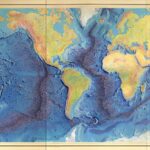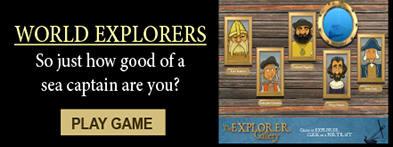Marie Tharp
Explorer
Modern
Quick Facts:
Oceanographer and geologist who helped create the first map of the ocean floor, proving that it was not just the flat surface most people believed it to be.
Introduction
Marie Tharp produced one of the world’s first maps of the ocean floor. Despite being a woman in a male dominated career, her work helped bring to life the unknown ocean world, and helped prove important information about our earth’s development.
Biography
Early Life
Marie Tharp was born in Ypsilanti, Michigan on July 30, 1920 to William and Bertha Tharp. Her father worked for the United States Department of Agriculture. He collected soil samples, rocks, and worked as a surveyor – someone who researches and charts areas. Marie often helped him with this task, which gave her an early introduction to map making. Because her father’s job required her family to move often, she attended about 17 different schools before she graduated from high school.1 When her father retired, the Tharps finally chose to settle in Bellefontaine, Ohio where they bought a farm. After she graduated high school a few years later, she took a year off before going to college to help out with the farm after her mother’s death in 1936. She entered the University of Ohio in 1939.
Because she was a female, Marie never thought she could do soil surveying like her father. Women during her time were deterred from working in the scientific field. She believed she’d be a teacher like her mother. At the time, jobs for young women were limited in options to: secretary, bookkeeper, nurse, school teacher or librarian.2 Marie began college as a music major, and graduated with a Music and English degree. After graduating, she had a rare chance to be part of an accelerated geology degree program in Michigan. This was in 1942 during World War II, so since many of the men were off fighting, there was opportunity for women to fill certain job roles. She earned her Master’s degree in Geology in 1944, and another bachelor’s degree in mathematics in 1948.3 After receiving her degree, she went to work as a research assistant at the Lamont Geological Laboratory in Columbia University in New York. While there, she met Bruce Heezen, a current geology graduate student, who she would collaborate with for the next 30 years.
Voyages
Principal Voyage
Before the 1950s, little was known about the layout of the ocean floor. Although Marie had a geology degree, she is also considered an oceanographer, someone who studies the ocean’s marine life and ecosystems. Prior to Tharp, the ocean floor had previously been envisioned as a flat plain of mud. Tharp and Heezen became part of a research project to map the topography – or layout – of the ocean floor. However, women at this time were not allowed on boats. So while Marie never physically got to voyage out to the sea while working on the ocean floor mapping, she was still the primary contributor to the success of the project.
Bruce Heezen went out on research vessels and collected the initial data. Much of the raw data came from SONAR measurements of the ocean depths. This data was sent to Marie back at home. She took the SONAR readings and working with only pens and rulers, drew the details of the ocean floor using longitude degree by latitude degree. It was a technical process, but Marie got the task done. The first published map of the North Atlantic ocean was in 1957.4 It was Tharp’s drawings that revealed that the ocean floor was not flat, but covered with features like canyons, ridges, and mountains just like on land. A second map showing the South Atlantic ocean floor was published in 1961;and then a map of the Indian ocean floor in 1964.5 Tharp completed a full world’s ocean map in 1977 titled The World Ocean Floor.
Subsequent Voyages
While completing her drawings, Tharp helped make an even bigger contribution to science when her maps revealed 40,000 miles of an underwater ridge that runs along the globe. In 1953, her observations led her to promote the theory of continental drift, or seafloor spreading – the idea that the continents move by spreading across the ocean bed. First mentioned by German meteorologist Alfred Wegener, continental drift had not been accepted as a theory. Tharp noticed that several of the small earthquakes occurring under the sea came from her proposed rift valley. However, the other scientists on the project continually rejected her findings.
Tharp continued on her work , and eventually her research more confidently proved the rift valley theory. Once again, she showed her evidence to Heezen, and he became convinced that she was correct. Marie Tharp proved the idea of continental drift, a huge accomplishment for the science community. It would still be several years before Tharp and Heezen’s findings were fully accepted in the geological scientific community.
Later Years and Death
Marie Tharp continued to work at the University of Columbia until she retired in 1983. She opened a map making business from her home in South Nyack, New York.6 As a woman scientist in the mid 20th century, Tharp’s work was not always credited. But in 1996 she received an Outstanding Achievement Award from the Society of Women Geographers; and in 1997 the Library of Congress’ Phillips Society honored her as one of the 20th Century’s Outstanding Cartographers.7 She passed away from cancer on August 23, 2006 at the age of 86.
Legacy
Marie Tharp is greatly recognized as a pioneer in a field dominated by men. Although more thorough maps of the ocean floor exist today, the impact of Tharp and her mapping of the ocean floor is still with us. She spent most of her career working in the background. Today, we openly recognize her contribution to oceanic exploration. Tharp, in partnership with Heezen, helped prove the theories of continental drift. But the most notable thing is that she helped map and illuminate a once unknown world – the ocean floor.
Endnotes
- Hali Felt, Soundings: The Story of the Remarkable Woman Who Mapped the Ocean Floor (New York: Henry Holt and Company, 2013), 34.
- Felt, Soundings, 33
- Henry R. Frankel, The Continental Drift Controversy: Volume 3, Introduction of Seafloor Spreading (New York: Cambridge University Press, 2012), 378
- Yount, Modern Marine Science: Exploring the Deep (New York: Chelsea House Publishers, 2006) 63
- Yount, Modern Marine Science, 63-64
- Yount, Modern Marine Science, 65
- Rachel Evans, https://www.loc.gov/loc/lcib/0211/tharp.html
Bibliography
Felt, Hali. Soundings: The Story of the Remarkable Woman Who Mapped the Ocean Floor. New York: Henry Holt and Company, 2013.
Frankel, Henry R. The Continental Drift Controversy: Volume 3, Introduction of Seafloor Spreading New York: Cambridge University Press, 2012.
Yount ,Lisa. Modern Marine Science: Exploring the Deep. New York: Chelsea House Publishers, 2006.
Gallery






